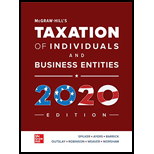
- 1. “The goal of tax planning is to minimize taxes.” Explain why this statement is not true.
Explain the reason for the given statement is not true.
Explanation of Solution
Tax Planning: It is the examining of a financial position or plan from the tax viewpoint. Tax planning makes sure of tax efficiency by reducing the tax liability and increasing the capability to make contribution for retirement plans that are vital for success.
The statement is wrong, because, the goal of tax planning is to maximize tax, not to minimize taxes. In general terms, the goal of tax planning is to maximize the taxpayers’ after tax wealth, while concurrently achieving the taxpayer’s non-tax goals.
Specially, maximizing after tax wealth requires one to consider both the tax and non-tax costs and benefits of other transactions, while tax minimization emphases only on a single tax.
Want to see more full solutions like this?
Chapter 3 Solutions
MCGRAW-HILL'S TAX.OF INDIV.+BUS.2020
Additional Business Textbook Solutions
Accounting Information Systems (14th Edition)
Principles of Microeconomics (MindTap Course List)
Intermediate Accounting (2nd Edition)
Horngren's Accounting (12th Edition)
Horngren's Cost Accounting: A Managerial Emphasis (16th Edition)
Operations Management: Processes and Supply Chains (12th Edition) (What's New in Operations Management)
- I am trying to find the accurate solution to this general accounting problem with appropriate explanations.arrow_forwardI am trying to find the accurate solution to this general accounting problem with appropriate explanations.arrow_forwardPinecrest Industries, Inc., has collected the following data on one of its products. The actual cost of the direct materials used is:arrow_forward
 Pfin (with Mindtap, 1 Term Printed Access Card) (...FinanceISBN:9780357033609Author:Randall Billingsley, Lawrence J. Gitman, Michael D. JoehnkPublisher:Cengage Learning
Pfin (with Mindtap, 1 Term Printed Access Card) (...FinanceISBN:9780357033609Author:Randall Billingsley, Lawrence J. Gitman, Michael D. JoehnkPublisher:Cengage Learning- Principles of Accounting Volume 1AccountingISBN:9781947172685Author:OpenStaxPublisher:OpenStax College





